What is Goya Champuru?
Goya Champuru (ゴーヤチャンプルー) is a beloved Okinawan dish where bitter melon (goya) is stir-fried with island tofu (島豆腐) and eggs, softening its flavor. Goya is a vegetable with a distinct bitterness, loved by many but often disliked by children due to its strong taste. While it is more authentic to use island tofu, this type of tofu is unique to Okinawa and can be difficult to find outside of the region. Firm tofu (momen) is commonly used as a substitute, even within Japan.
According to the Ministry of Agriculture, Forestry, and Fisheries’ Annual Production of Regional Specialty Vegetables (2020), goya shipments totaled 17,900 tons nationwide, with Okinawa (6,070 tons), Miyazaki (2,600 tons), and Kagoshima (1,670 tons) as the main production areas. Most production areas in Japan are in the south.
“Champuru” in Okinawan means “jumbled” and refers to dishes made with tofu and various ingredients. For instance, if the dish is made with beansprouts (māminā in Okinawan), it becomes “māminā champuru”. The funny thing is that “champuru” is believed to originate from the Malay or Indonesian word “campur”!
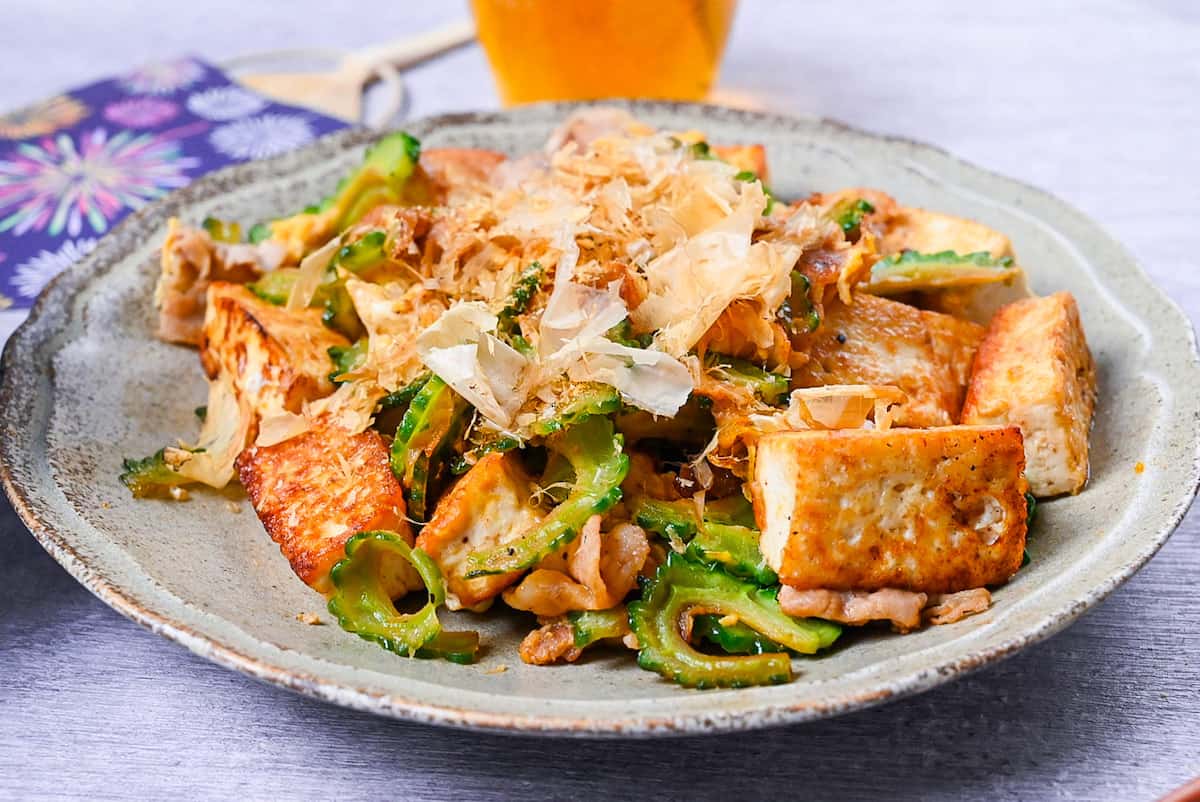
Ingredients & Substitution Ideas
- Okinawan Bitter Melon (Goya): When you’re picking out melons, go for ones that are bright and dark green, and make sure they’re heavy for their size. The surface should have firm warts that are evenly distributed and undamaged. A fresher goya has more nutrients, but it’s also more bitter. If you can’t find goya or want something milder, cabbage, bean sprouts, or papaya are good options.
- Thinly Sliced Pork Belly: Pork is the go-to for an authentic flavor, and thinly sliced pork belly is the top pick. You can also use unsmoked bacon as a substitute.
- Firm Tofu: If you can’t get island tofu, firm tofu is a great substitute.
- Egg: Adding beaten eggs balances out the dish, making the goya less bitter.
- Soy Sauce: For tips on choosing the right soy sauce, check out my full guide to soy sauce.
- Bonito Flakes (Katsuobushi): Top it off with a sprinkle of these for a finishing touch. They’re optional.
You can easily make goya champuru suitable for vegetarians. Simply omit the pork belly and katsuobushi!
Jump to Full Recipe Measurements
Visual Walkthrough & Tips
Here are my step-by-step instructions for how to make Goya Champuru at home. For ingredient quantities and simplified instructions, scroll down for the Printable Recipe Card below.
If you prefer to watch the process in action, check out my YouTube video of this recipe for a complete visual walkthrough!
I must admit goya is one of the most bitter vegetables I have had in my whole life, but the bitterness is part of the beauty of this unique vegetable. It is vital to prepare goya properly to soften the bitterness slightly and improve the overall flavor.
First, wash the goya and cut off the top. Next, cut them in half lengthwise and scoop out the seeds using a spoon.
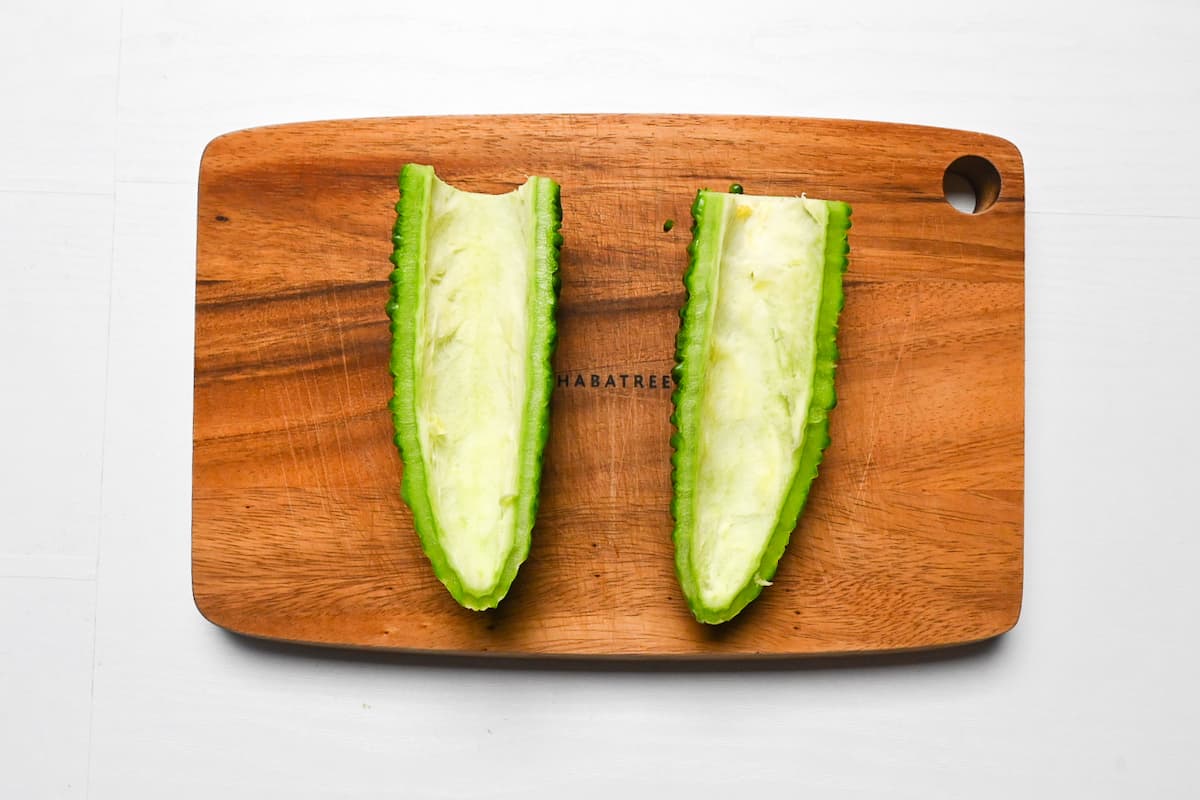
The inside is not quite as bitter as the outer green part, so don’t worry about getting every last bit here.
Next, turn the goya halves over (this will stop them from rolling) and cut slices about 5mm thick.
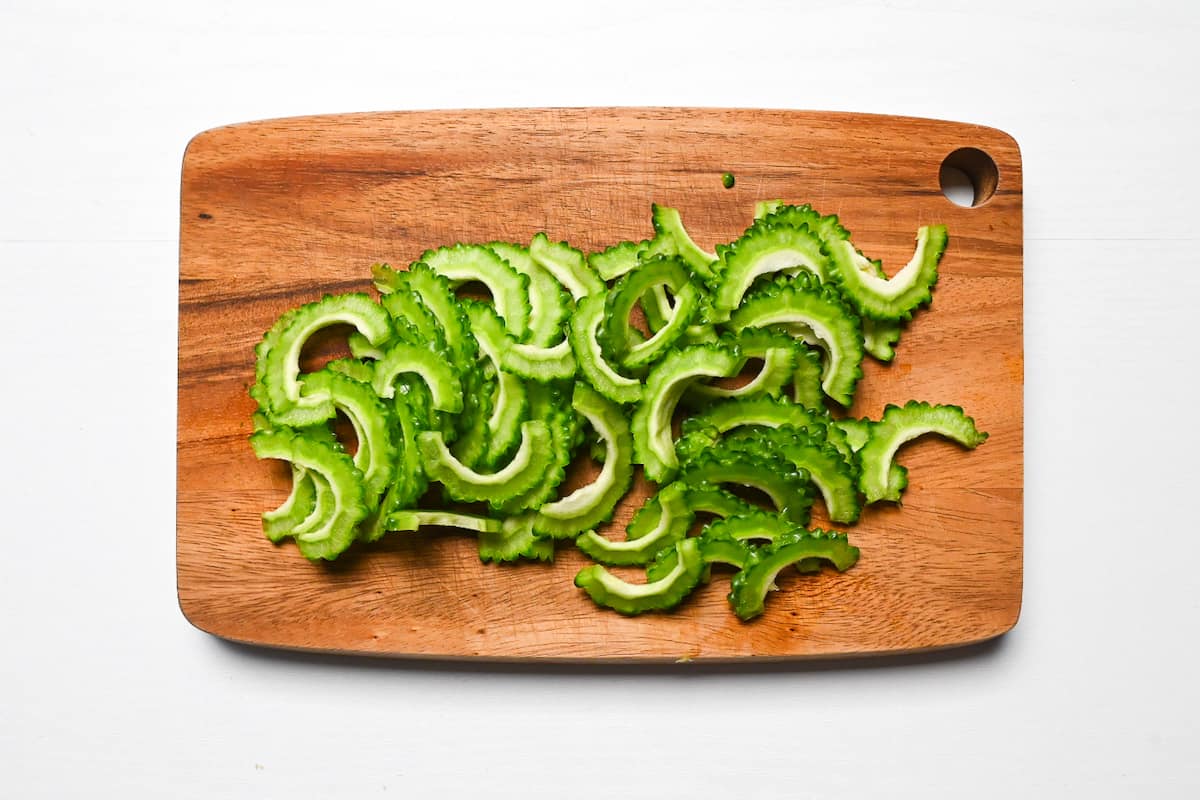
If it’s cut too thin, the texture will be lost, and if cut too thick, the bitter taste will become stronger and more obvious, so it is important to cut at just the right thickness.
Next, rub the sliced goya with salt and sugar. The salt helps bring out the flavor, while the sugar helps balance the bitterness. Leave it to rest for 10 minutes.
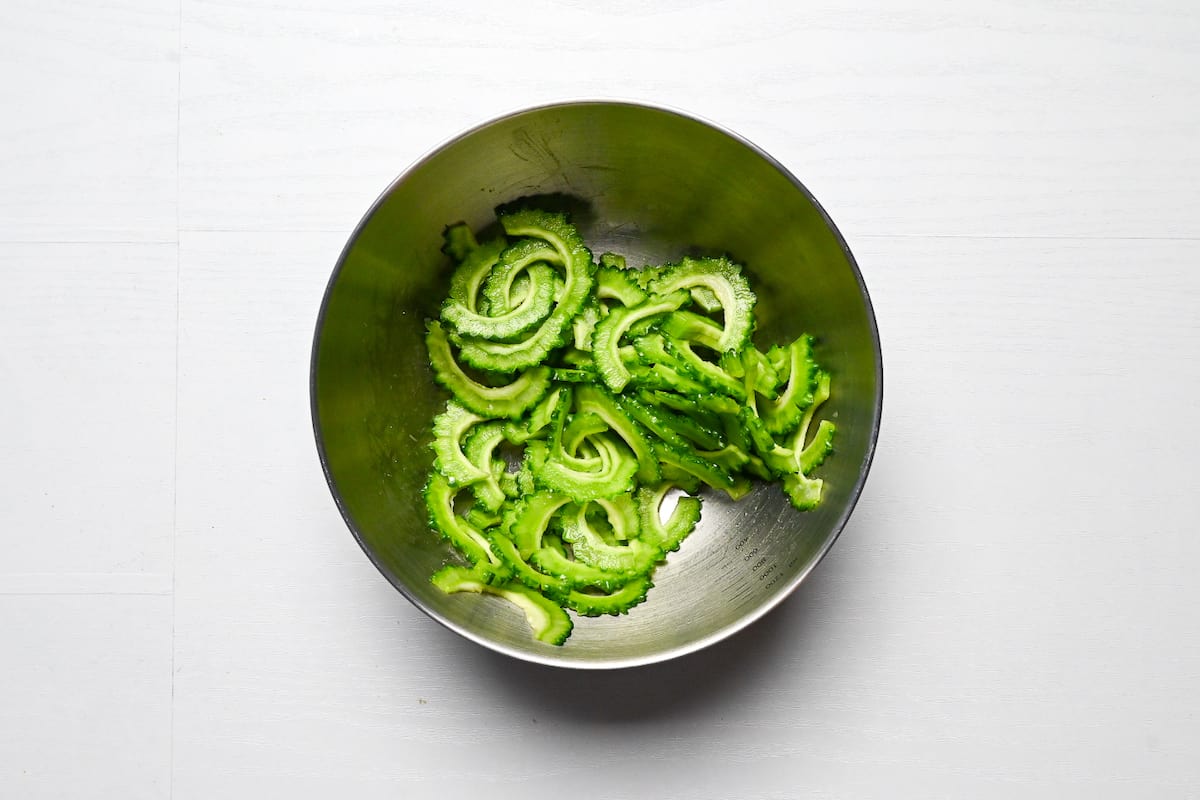
After the 10 minutes are up, wash the goya with cold water.
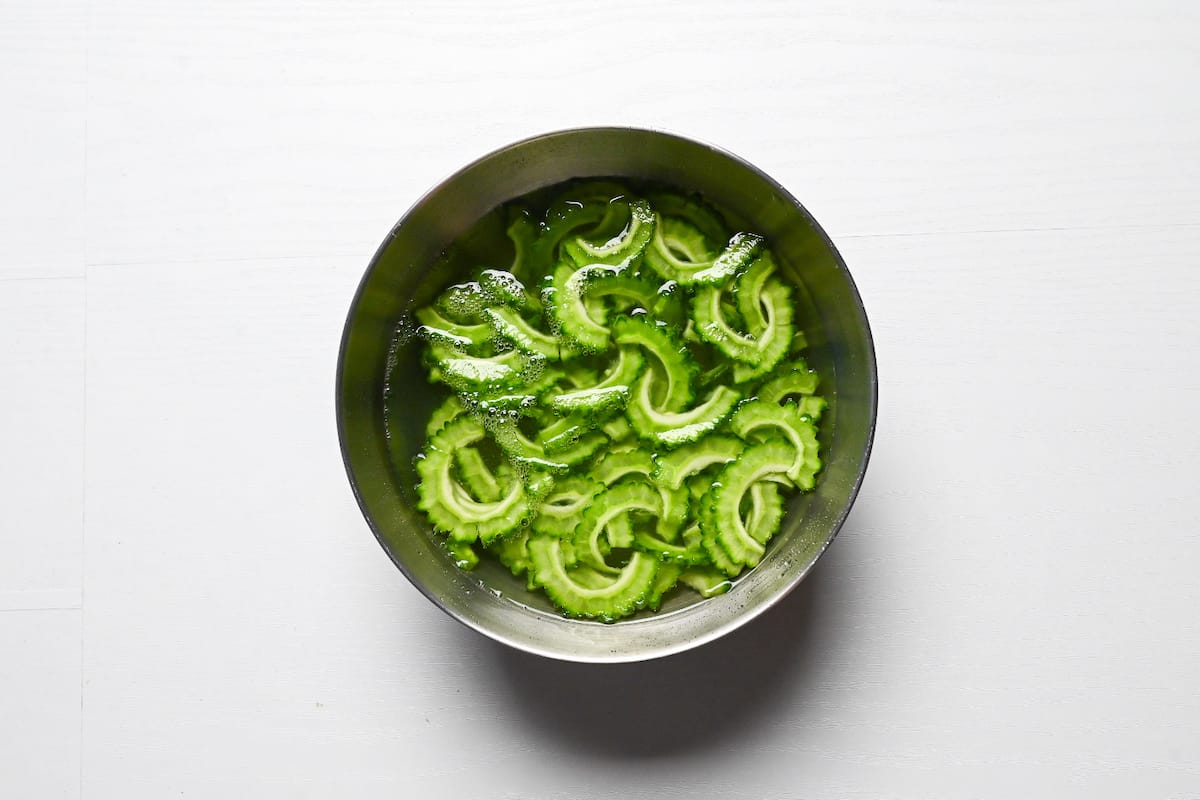
Pour the contents of the bowl through a sieve or colander to drain the water and set the goya aside for later.
Before stir-frying tofu, you need to remove the excess liquid. Rather than pressing the tofu (which takes time), I wrap it with kitchen paper and microwave it for 1 1/2 minutes at 600W.
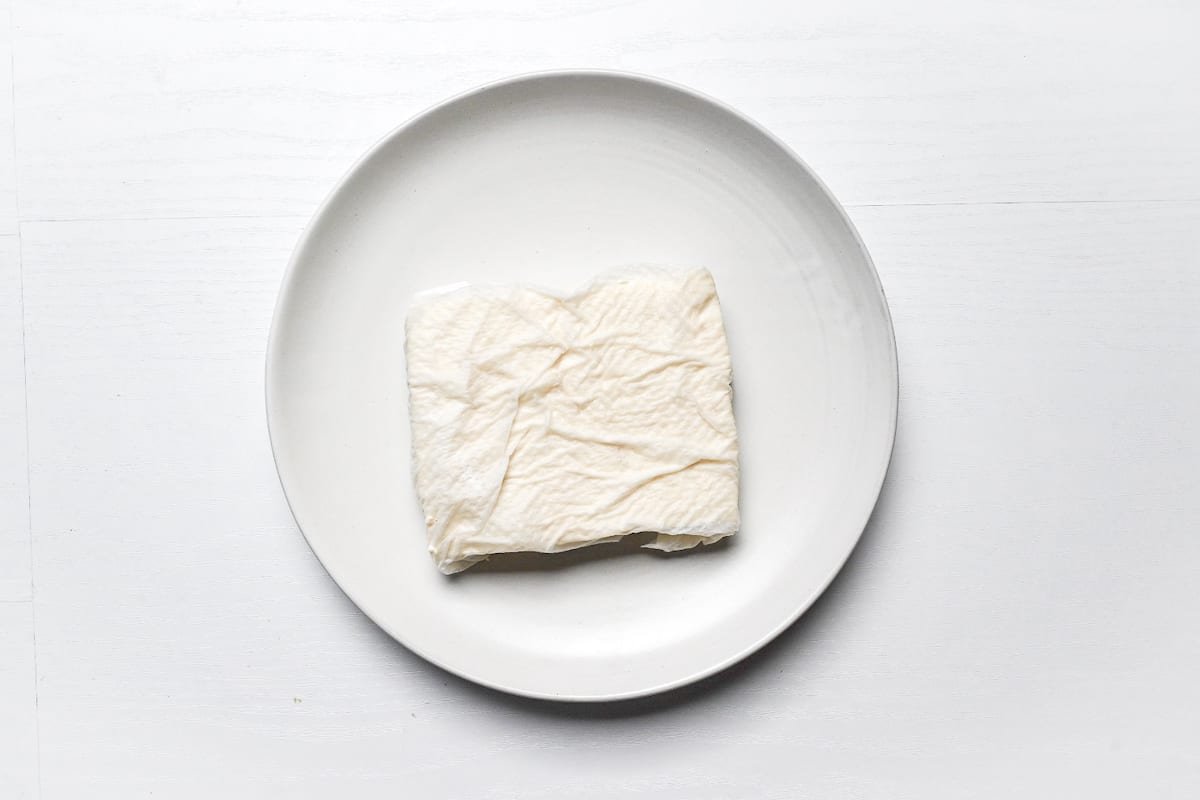
Allow it to cool for a few minutes, remove the kitchen paper, and pat it dry.
You can now cut it into bitesize cubes like this.
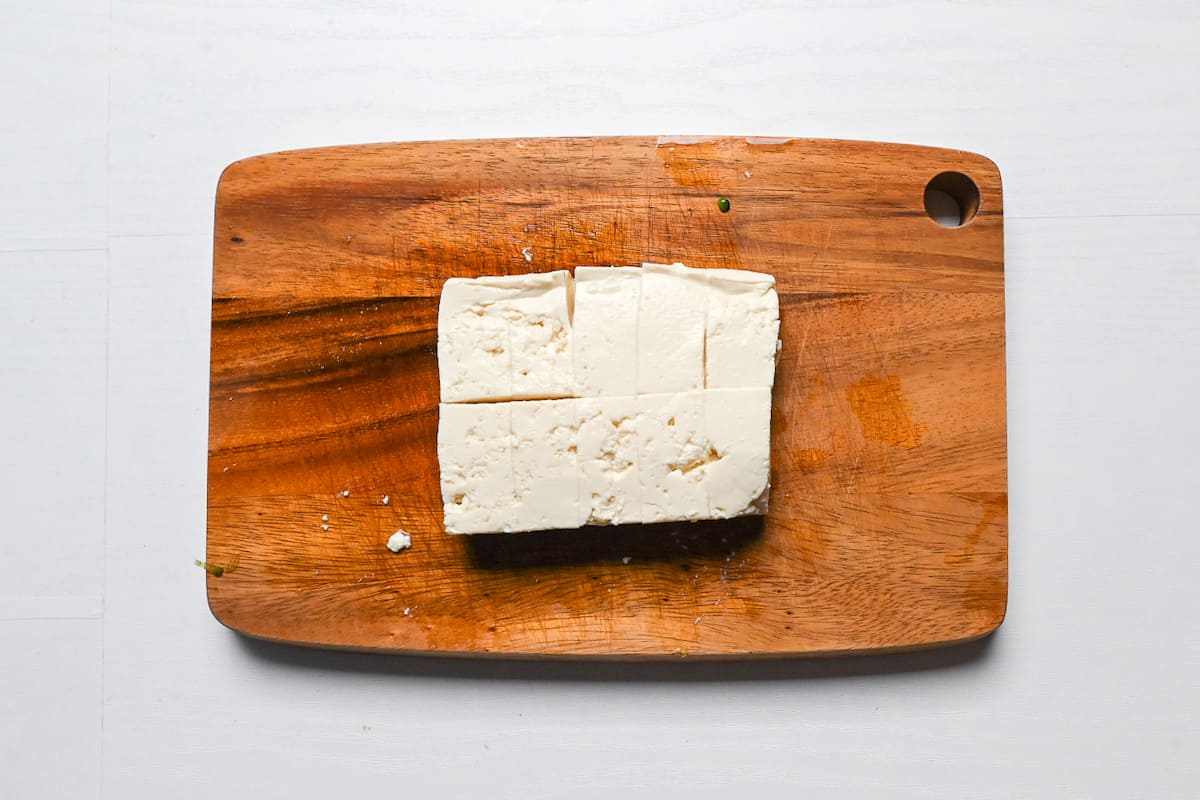
It’s now ready to cook!
For this recipe, I like to stir-fry the tofu on its own. This allows it to become crispy and turn a beautiful golden color without interference from the fats and liquids from the other ingredients.
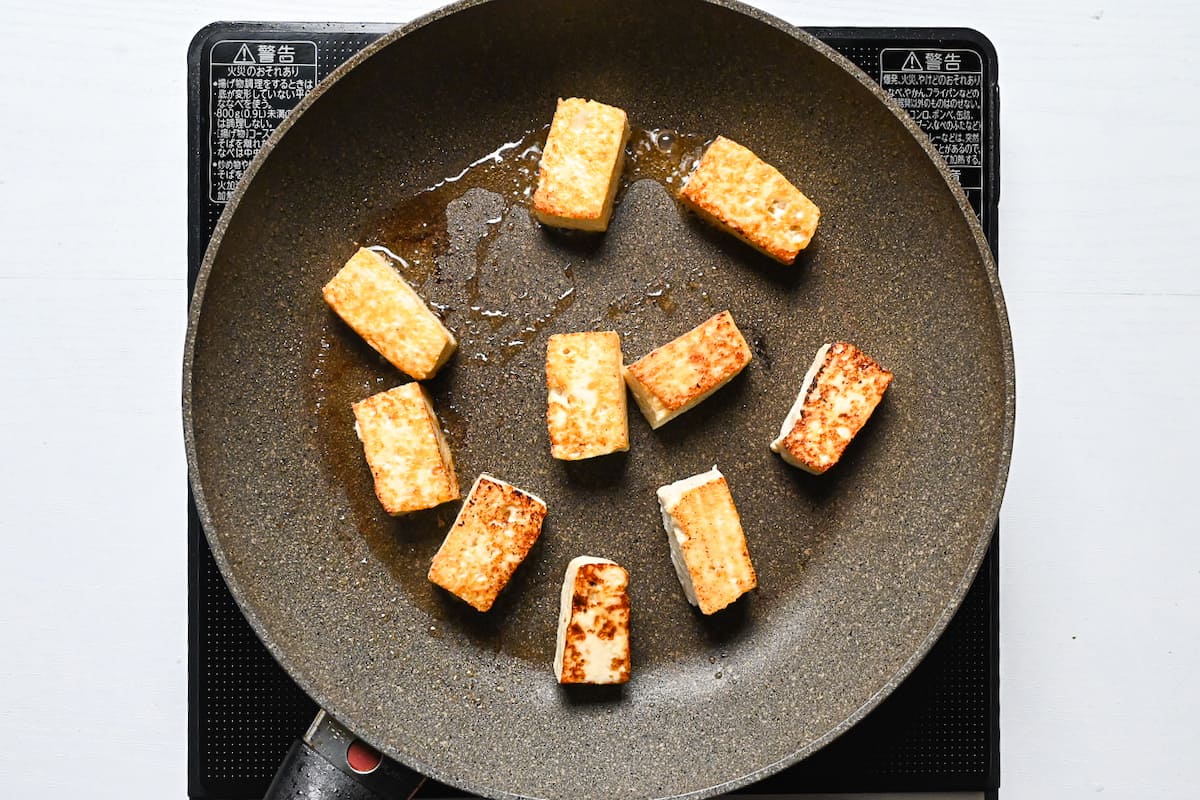
Remove it from the pan and set it aside so it stays beautiful and doesn’t break or become overcooked!
Using the same pan, fry the pork belly until it’s sealed on both sides and add the sliced goya. Stir fry them together for 2-3 minutes.
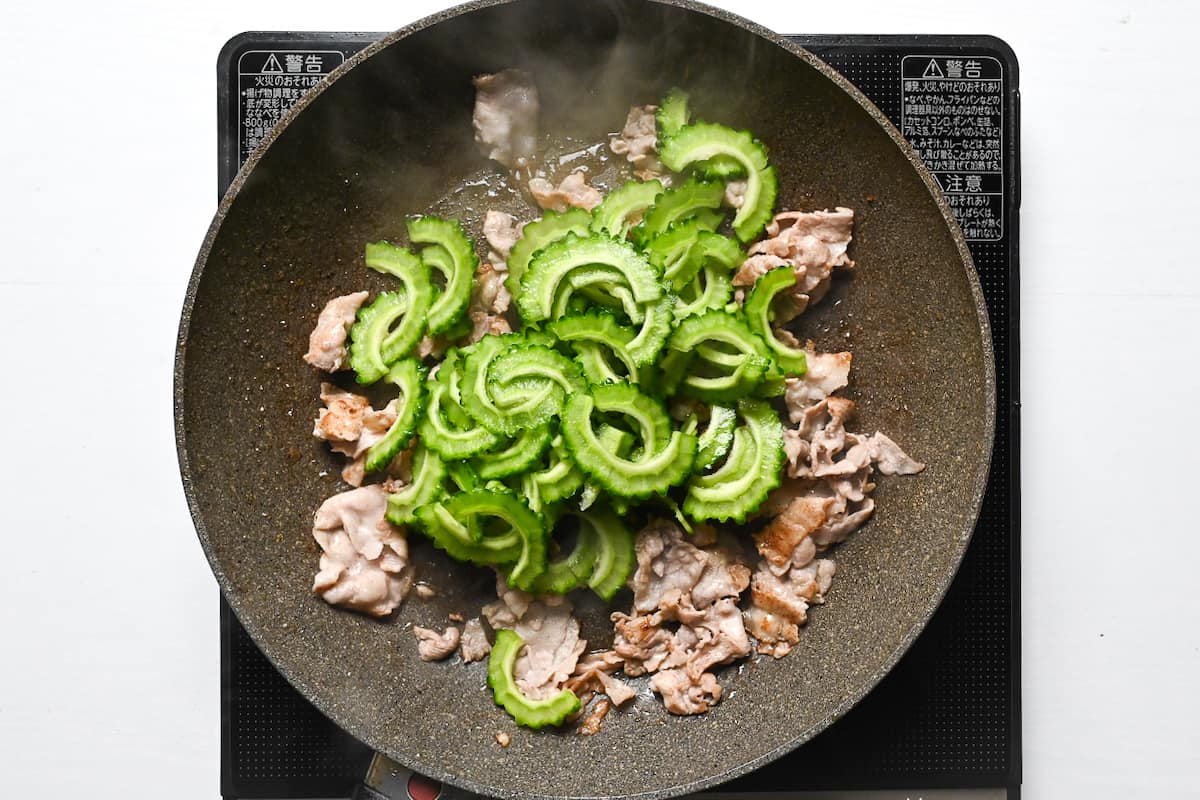
Next, add the tofu back in with a pinch of salt and pepper and mix.
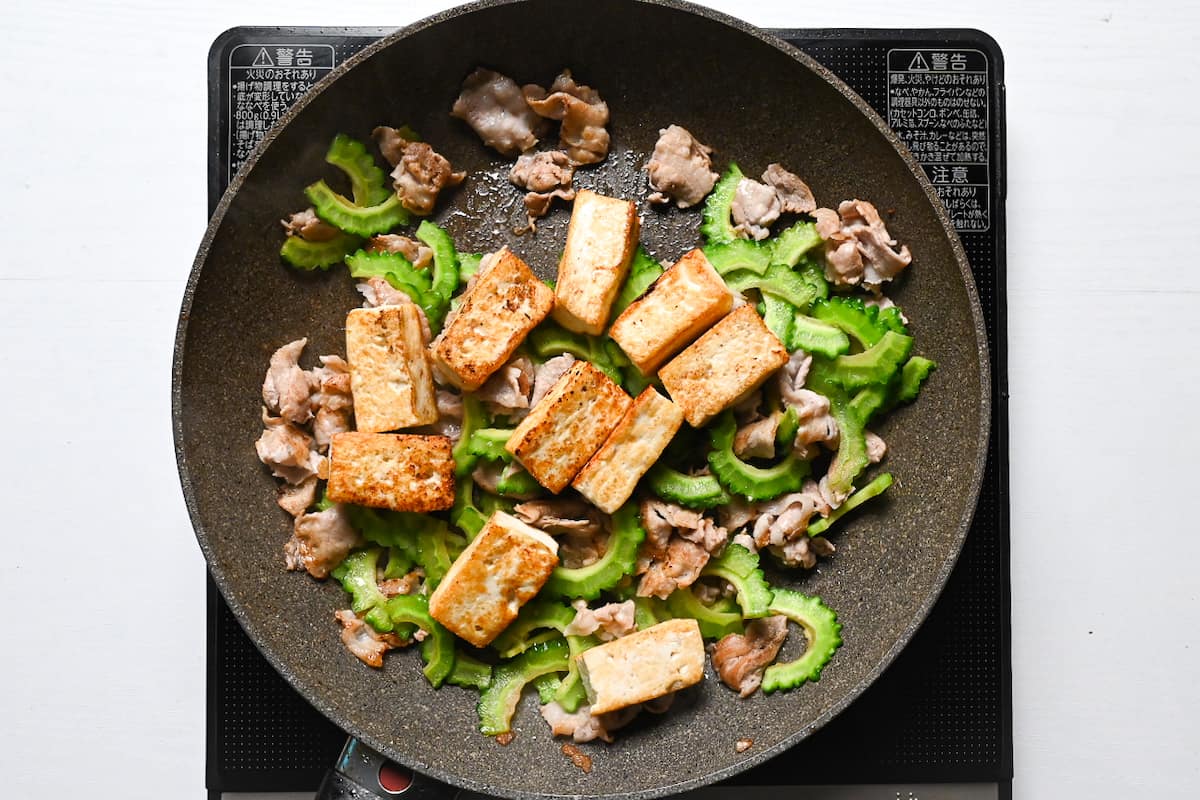
Add a dash of soy sauce and mix again.
Whisk the egg in a separate bowl and pour it into the pan.
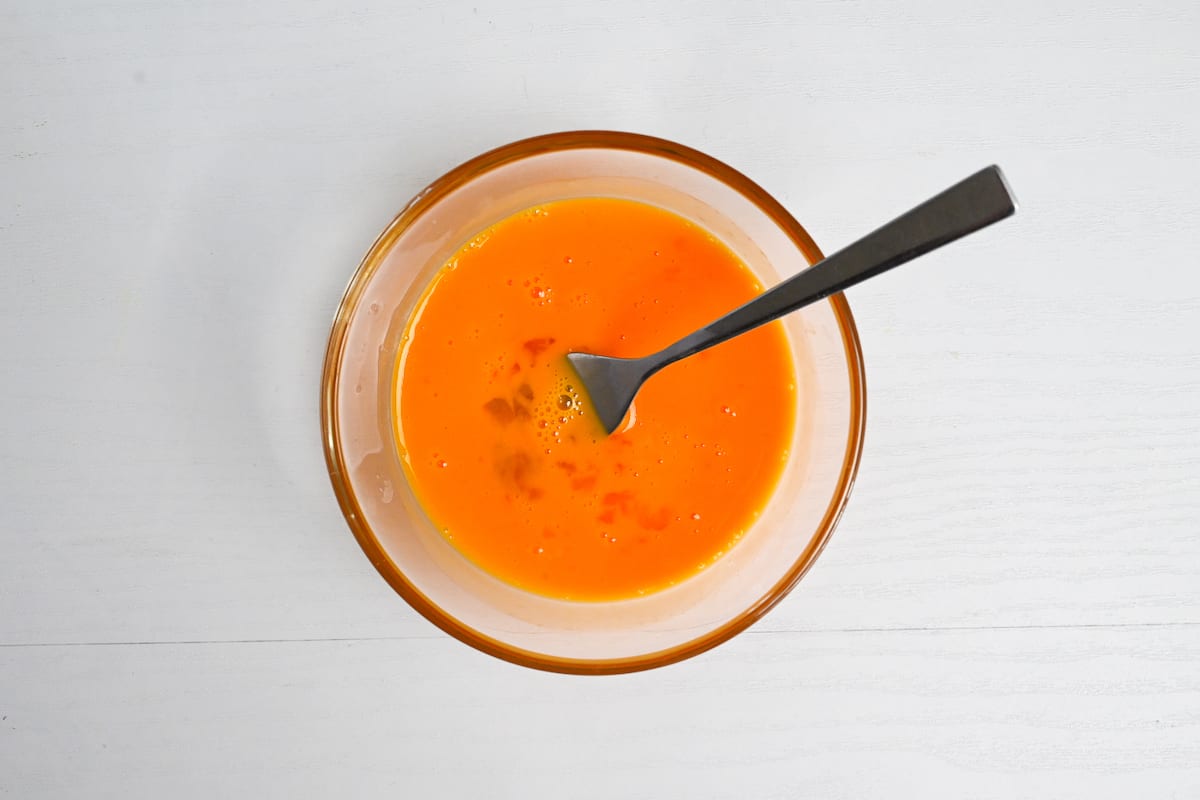
Allow the eggs to become half-cooked before mixing. If you mix too early, the egg will break up into small pieces and become lost amongst the other ingredients.
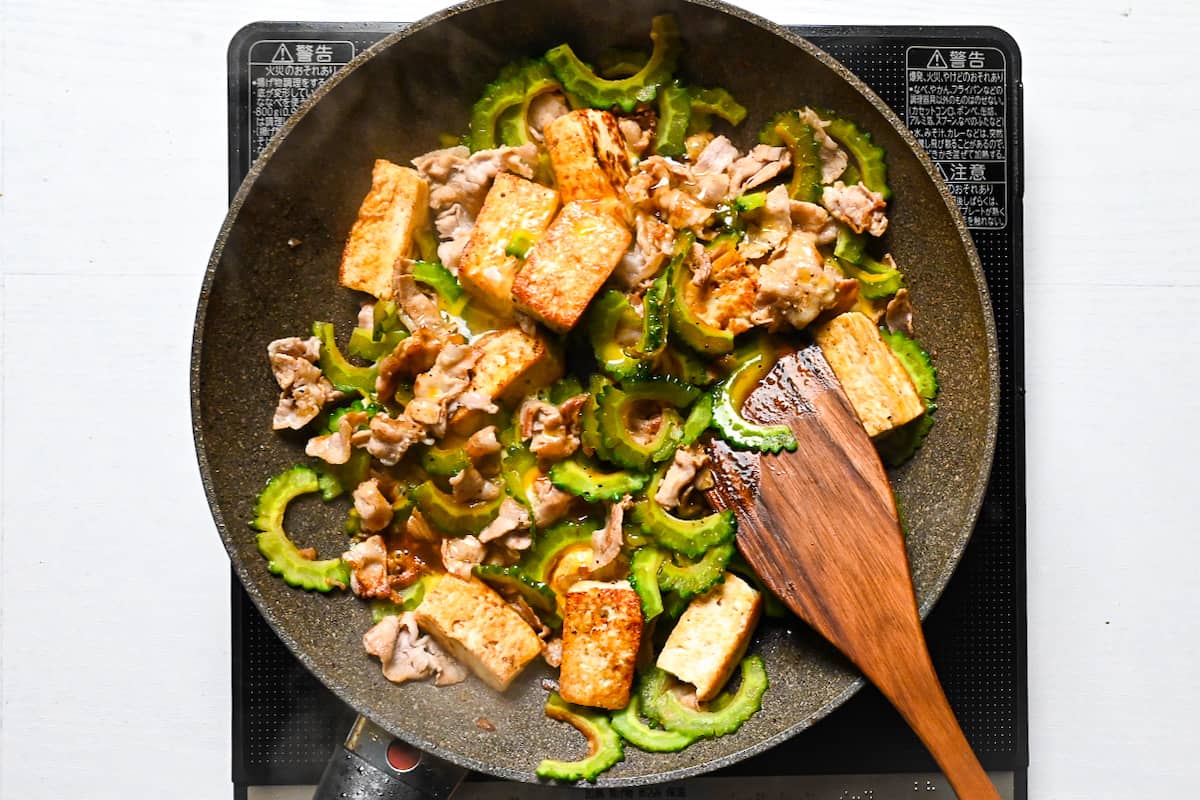
Once the egg is half cooked, add a dash of soy sauce, mix quickly, and remove from the heat.
The eggs will continue to cook in the residual heat from the other ingredients. Taking it off the stove early prevents overcooked, rubbery eggs!
Dish up and sprinkle with kastuobushi (bonito flakes).

Goya Champuru goes well with rice or noodles!
Jump to Full Recipe MeasurementsHow to Store
The best way to store leftover goya champuru is through refrigeration. However, due to the presence of eggs and tofu, it should not be kept for more than 2 days. Freezing is not recommended.
Storage summary
Room temperature – Not recommended.
Refrigerated – Up to 2 days.
Frozen – Not recommended.
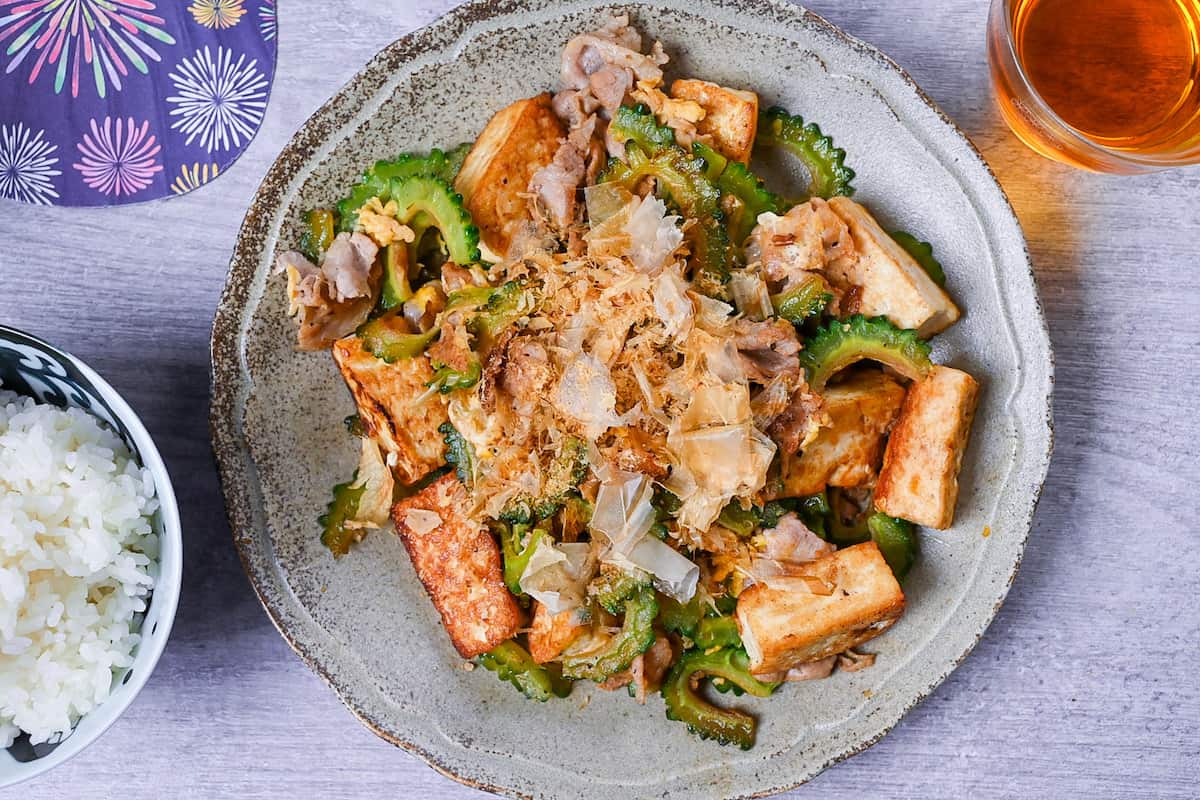
FAQ
Goya is the Okinawan name for the cucurbitaceous plant often known as bitter melon or bitter goard in English. In Japanese, it is known as both goya (ゴーヤー) and nigauri(苦瓜) which directly translates as bitter melon. This unique ingredient is primarily used as a vegetable in its green, unripe form.
Champuru is an Okinawan word that means jumbled and is said to be derived from the Malay or Indonesian word campur. Champuru generally refers to stir-fried dishes containing several different ingredients, the most popular being goya champuru and māminā champuru (beansprouts).
It is believed that goya originated in Africa and spread across Asia. It is commonly used in East Asian, South Asian, and Southeast Asian cooking.

I hope you enjoy this Goya Champuru recipe! If you try it out, I’d really appreciate it if you could spare a moment to let me know what you thought by giving a review and star rating in the comments below. It’s also helpful to share any adjustments you made to the recipe with our other readers. Thank you!
More Japanese Stir-fry Recipes

Goya Champuru (Okinawan Bitter Melon Stir Fry)
Ingredients
- 1 Okinawan bitter melon (goya)
- ½ tsp salt
- ¼ tsp sugar
- 150 g thinly sliced pork belly
- 1 pinch salt and pepper
- 200 g firm tofu
- 1 egg whisked
- 1 tsp Japanese soy sauce (koikuchi shoyu) for cooking
- 1 tsp Japanese soy sauce (koikuchi shoyu) for finishing
- 1 tbsp bonito flakes (katsuobushi)
- 1 tbsp cooking oil
My recommended brands of ingredients and seasonings can be found in my Japanese pantry guide.
Can’t find certain Japanese ingredients? See my substitution guide here.
Instructions
- First, cut 1 Okinawan bitter melon (goya) in half lengthways and scoop out the seeds.

- Cut it into 5mm slices and place in a bowl. Add ½ tsp salt and ¼ tsp sugar and massage until evenly covered. Rest for 10 minutes.

- Next, wrap 200 g firm tofu with kitchen paper and place it on a microwavable plate. Microwave uncovered for 1 1/2 minutes at 600W to remove the excess liquid. Leave to cool for a few minutes.

- After the 10 minute rest, fill the bowl of goya with fresh water and pour it through a colander to drain. Shake thoroughly and set by the stove for later.

- Once the tofu is cool enough to touch, cut it into bitesize cubes and start heating a frying pan on medium.

- Once the pan is hot, add 1 tbsp cooking oil. Add the tofu and brown it on each side. Once it's brown and slightly crispy on the outside, remove it from the pan and transfer it to a heatproof plate.

- Reuse the pan to sear 150 g thinly sliced pork belly on both sides.

- Add the goya to the pan and stir fry with the pork for 2-3 minutes.

- Add the tofu back into the pan and sprinkle with 1 pinch salt and pepper. Pour 1 tsp Japanese soy sauce (koikuchi shoyu) around the edge of the pan and mix everything thoroughly.

- Crack 1 egg into a bowl and whisk until the whites and yolks are combined. Pour it into the pan and without mixing, cook until half done.

- Add another 1 tsp Japanese soy sauce (koikuchi shoyu) and mix thoroughly to break up the egg.

- Plate up and sprinkle 1 tbsp bonito flakes (katsuobushi) over the top. Enjoy!






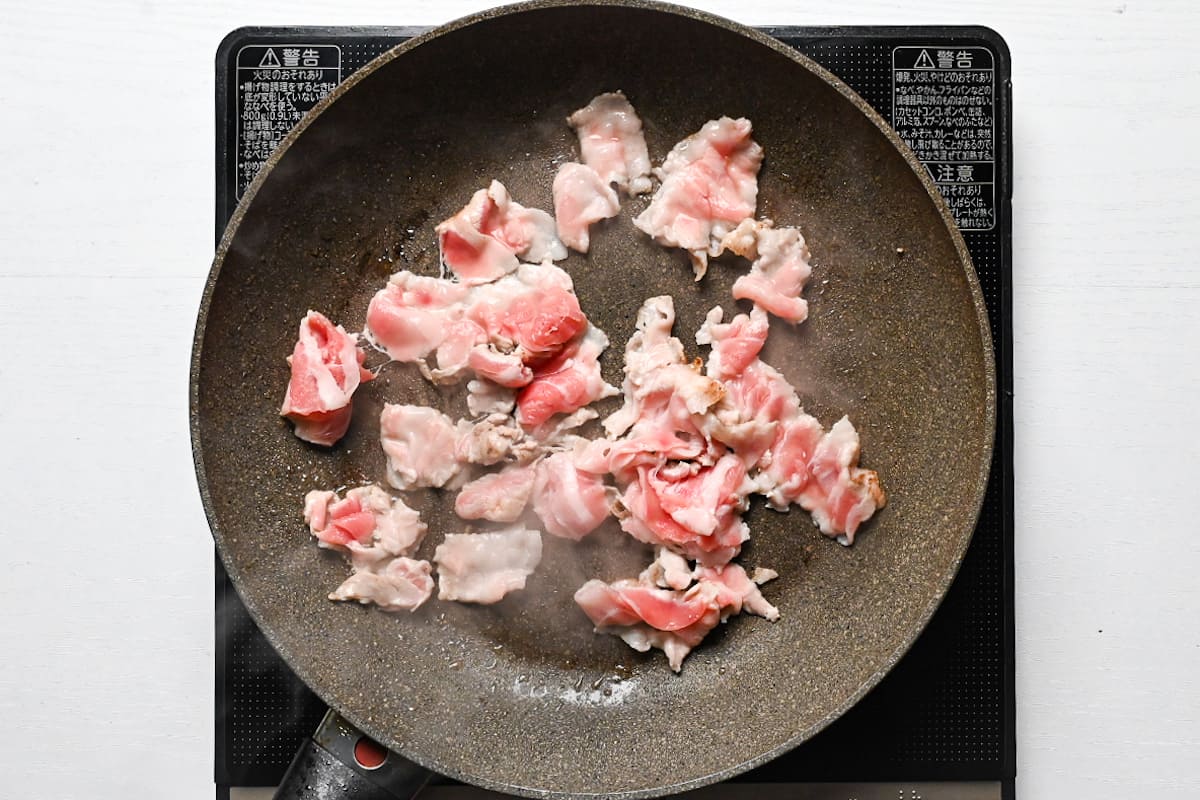
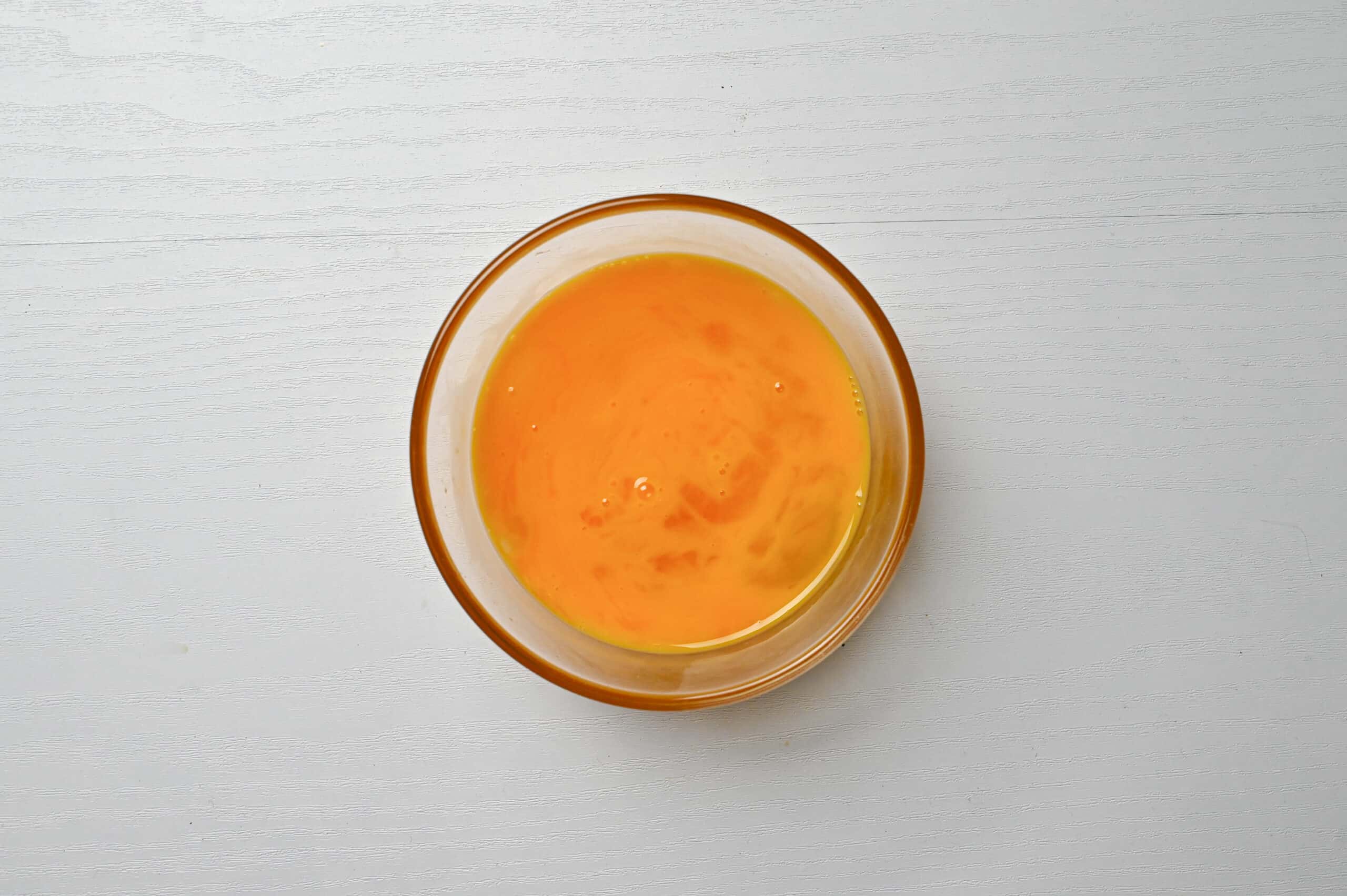
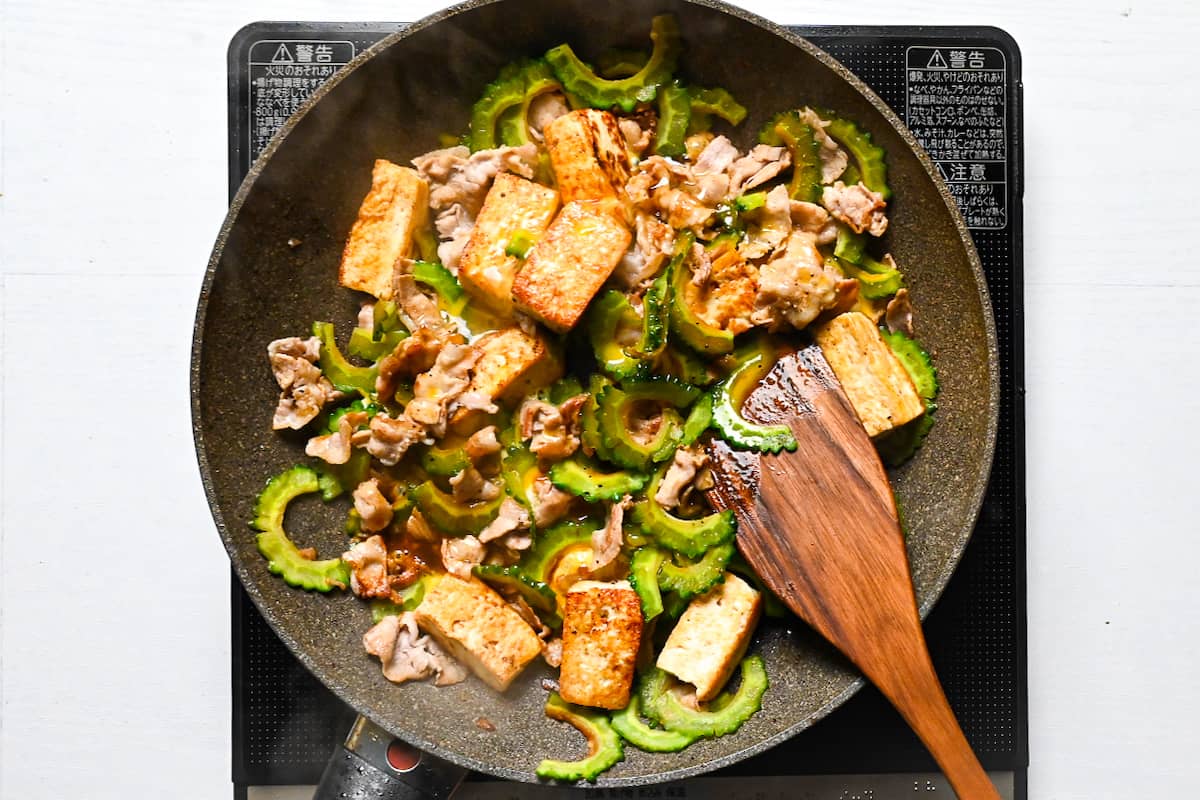
Leave a rating and a comment